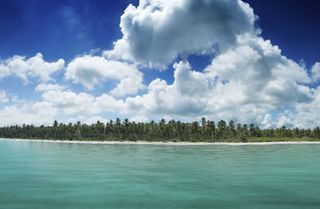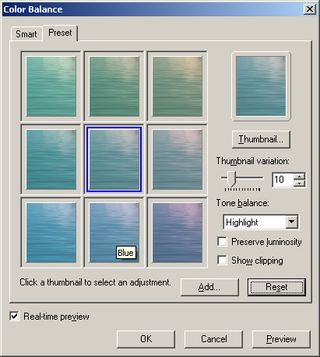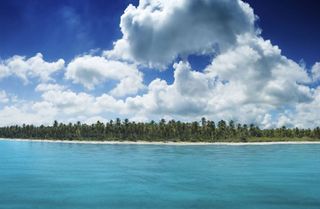How to Salvage Photos Gone Horribly Wrong
Not everybody has time to learn photography 101. Here’s how to make the best of bad images after the damage has been done, with software.
Keeping the Ocean Blue with Color Thumbnails
Oceans and other bodies of water are commonly seen in photographs, probably because we take so many photos when we’re on vacation. Although we tend to think of the ocean as being blue, a lot of factors, from pollution to reflections to poor color capture in an inexpensive camera, can cause oceans to take on a somewhat green appearance, as seen in the photo below.

Thus far, I’ve avoided using selection masks when demonstrating various adjustments, since the process can become tedious. However, selecting a body of water with your image editor’s magic wand (or similarly named) tool is often a one-step process. Once you’ve selected the body of water, you can use a tool such as PhotoImpact’s Color Balance filter, which provides thumbnail adjustments using shades of red, orange, yellow, green, teal, cyan, blue, and magenta.

Note that this tool is called Color Hue in Photo-Paint and Variations in Photoshop. A click or two on the cyan or blue thumbnails will likely give you a properly tinted blue ocean.

The water in the new image was color corrected by using two clicks of the cyan thumbnail.
Sign up to get the BEST of Tom's Guide direct to your inbox.
Get instant access to breaking news, the hottest reviews, great deals and helpful tips.
Current page: Keeping the Ocean Blue with Color Thumbnails
Prev Page Hue Adjustment for Color Correction Next Page Working with the Unbearably Bad Photo–Getting Started-
superhighperf how about fixing the photo that was in the cover?Reply
http://media.bestofmicro.com/adjustment-saturation-tuning,0-4-178852-2.jpg
bait and switch article ?!?!?!?! -
As a professional VFX artist, I have to say that this article is a little on the juvenile side. Some of the "after" photos contain less information than the "before" photos. You never want to clip information in your photograph, and always want even exposure. Never underestimate a good matte for affecting only certain portions of your image. Furthermore, a good levels adjustment never hurt, and can always add some "punch" to your image.Reply
-
The article text provides a reasonable introduction to basic photo editing, but the "fixed" photos are perfect examples of what happens when a beginner goes way, way overboard. It's too bad because the miserable "after" photos significantly undermine the credibility of the article.Reply
-
mediv42 Why do people insist a bluer sky or greener trees make a better picture? Isn't the point of photography to capture what actually is, not whimsically change it to what you want it to be? Sure I understand if you underexposed the photo, or your white balance is off or whatever, but shouldn't the goal generally be what the subject actually looked like?Reply -
idisarmu This reminds me of the millions upon millions of teenage girls who see a picture of themselves and say, "Oh noes!!! ACNE!" *cries for hours and then suddenly has epiphany* "WAIT! I've GOT IT! I'll just crank up the brightness and make the picture black&white! THANK YOU COMPUTER!"Reply -
AARRGGHHH idisarmuThis reminds me of the millions upon millions of teenage girls who see a picture of themselves and say, "Oh noes!!! ACNE!" *cries for hours and then suddenly has epiphany* "WAIT! I've GOT IT! I'll just crank up the brightness and make the picture black&white! THANK YOU COMPUTER!"Reply
Black and White hides zits? That IS an epiphany.
I enjoyed the article.
